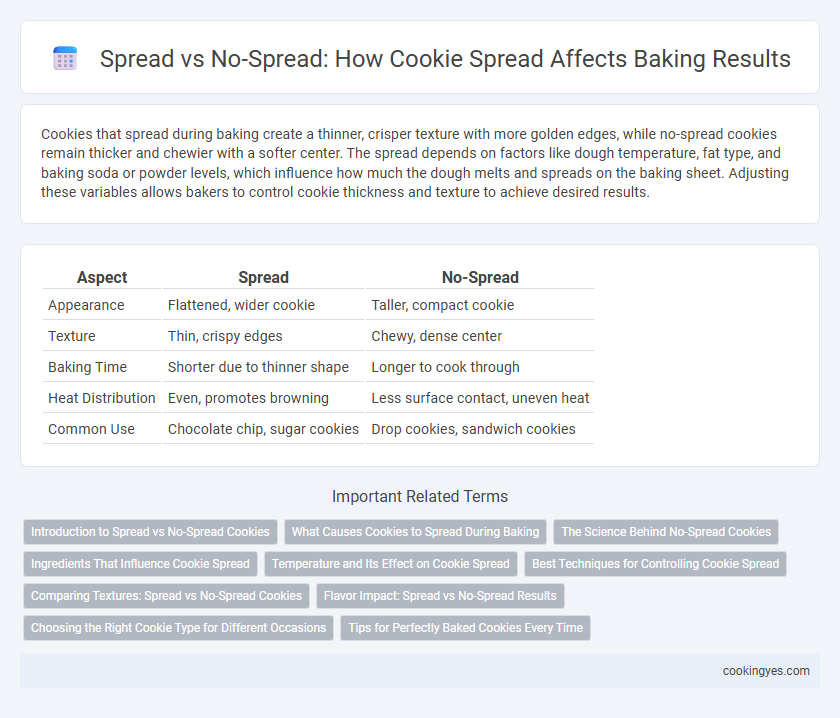Cookies that spread during baking create a thinner, crisper texture with more golden edges, while no-spread cookies remain thicker and chewier with a softer center. The spread depends on factors like dough temperature, fat type, and baking soda or powder levels, which influence how much the dough melts and spreads on the baking sheet. Adjusting these variables allows bakers to control cookie thickness and texture to achieve desired results.
Table of Comparison
| Aspect | Spread | No-Spread |
|---|---|---|
| Appearance | Flattened, wider cookie | Taller, compact cookie |
| Texture | Thin, crispy edges | Chewy, dense center |
| Baking Time | Shorter due to thinner shape | Longer to cook through |
| Heat Distribution | Even, promotes browning | Less surface contact, uneven heat |
| Common Use | Chocolate chip, sugar cookies | Drop cookies, sandwich cookies |
Introduction to Spread vs No-Spread Cookies
Spread cookies tend to thin out and flatten during baking, creating a crisp edge and chewy center due to higher fat and sugar content, while no-spread cookies maintain their shape and thickness, often achieved by using less fat or adding stabilizers like flour or chilling the dough. Spread behavior impacts texture and appearance, influencing consumer preference and baking consistency. Understanding the role of ingredient ratios and dough temperature is crucial for controlling cookie spread and achieving desired bake results.
What Causes Cookies to Spread During Baking
Cookie spread during baking is primarily caused by the fat type and amount, sugar content, and oven temperature. Butter melts quickly, resulting in more spread, while shortening melts slower, reducing spread. High sugar levels increase spread by liquefying during baking, and warmer oven temperatures cause faster fat melting, leading to greater cookie spread.
The Science Behind No-Spread Cookies
No-spread cookies maintain their shape due to a higher proportion of flour and lower fat content, which increases dough viscosity and reduces melting during baking. The balance between leavening agents such as baking soda and baking powder also influences gas production, controlling expansion and preventing excessive spreading. Temperature plays a critical role; colder dough slows fat melting, preserving cookie structure, while flour type impacts gluten formation, further stabilizing no-spread cookie texture.
Ingredients That Influence Cookie Spread
Ingredients that influence cookie spread include the type of fat, sugar, and flour used, as they directly affect the dough's consistency and melting point. Butter, due to its lower melting temperature, typically causes more spread compared to shortening or margarine, while granulated sugar increases spread by liquefying during baking, in contrast to brown sugar which retains moisture and limits spread. Higher protein flours absorb more moisture, reducing spread and creating a thicker cookie, while lower protein flours yield a softer, more expansive texture.
Temperature and Its Effect on Cookie Spread
Higher baking temperatures cause cookie dough to spread less due to rapid crust formation, which limits outward flow during baking. Lower temperatures allow cookies to spread more widely as the dough remains softer longer before setting. Understanding these temperature effects helps achieve desired cookie textures by controlling spread during the bake process.
Best Techniques for Controlling Cookie Spread
Controlling cookie spread involves precise manipulation of dough temperature, ingredient ratios, and baking conditions, with chilling the dough being a key technique to limit spread by solidifying fats before baking. Using higher protein flour and reducing sugar content also help minimize cookie spread by strengthening gluten formation and reducing moisture. Adjusting oven temperature to a higher setting encourages quicker crust formation, which further restricts excessive spreading during baking.
Comparing Textures: Spread vs No-Spread Cookies
Spread cookies have a thinner, crispier texture due to the dough melting and expanding during baking, creating a delicate crunch at the edges and a chewy center. No-spread cookies retain their shape, offering a denser, cake-like texture with a soft and tender bite throughout. The choice between spread and no-spread impacts not only appearance but also the cookie's mouthfeel and overall eating experience.
Flavor Impact: Spread vs No-Spread Results
Cookie spread during baking significantly influences flavor development by affecting caramelization and Maillard reactions on the surface. Spread cookies expose more dough to heat, enhancing browning and creating deeper, richer flavors compared to no-spread cookies, which retain a softer, milder taste. Controlling spread can optimize the balance between texture and flavor intensity in the final bake results.
Choosing the Right Cookie Type for Different Occasions
Choosing between spread and no-spread cookies depends on the occasion and desired texture; spread cookies like chocolate chip offer a chewy, crispy edge ideal for casual gatherings, while no-spread cookies such as shortbread deliver a dense, crumbly bite suited for elegant events. Spread cookies typically require higher butter content and lower flour, creating a wider, thinner cookie perfect for sharing, whereas no-spread cookies use higher flour and less fat to maintain shape and structure. Selecting the right cookie type enhances presentation and enjoyment, aligning texture and appearance with the event's tone and guest preferences.
Tips for Perfectly Baked Cookies Every Time
Controlling cookie spread is essential for achieving perfectly baked cookies with the ideal texture and shape. Use chilled dough to minimize excessive spreading and ensure even baking, while adjusting oven temperature to around 350degF (175degC) promotes optimal rise and controlled spread. Incorporate the right balance of butter and flour, and avoid over-mixing the dough to maintain consistent cookie structure and prevent flat or overly thin results.
Spread vs No-Spread for Bake Results Infographic

 cookingyes.com
cookingyes.com